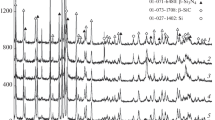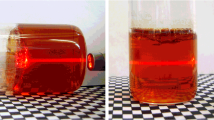Abstract
Problems concerning sol–gel synthesis of ceramic nanomaterials, methods of investigation of these materials and of processes proceeding with their participation have been presented. One-component nc-TiC, nc-TiN and multi-component TiC + SiC + C and Ti(C,N) + Si(C,N) + Si3N4, powders have been investigated. The sol–gel synthesis is carried out in two stages: low-temperature, in which the raw nc-TiCx product is obtained, and high-temperature one. In the high-temperature stage carbonization of carbides and elimination of excessive organic compounds, being the source of carbon in carbonization process, take place. It has been demonstrated that the oxygen, present at trace level in argon, can react with components of the system in certain range of temperature, influencing the quality of obtained product. High-temperature oxidation resistance of investigated materials in dry air was also determined, applying kinetic methods. TG-DSC measurement data were used as the basis of kinetic analysis. The method of investigation has been presented at the example of TiC + SiC + C powder oxidation. Is has been demonstrated, that in case of multi-component materials, components were oxidized in temperature ranges characteristic for pure phases.












Similar content being viewed by others
Abbreviations
- α:
-
Conversion degree
- A :
-
Pre-exponential Arrhenius factor (1/min)
- β:
-
Sample heating rate (K/min)
- E :
-
Apparent activation energy (J/mol, kJ/mol)
- g(α):
-
Integral form of kinetic model
- f(a):
-
Conversion function dependent on mechanism of reaction
- R :
-
Gas constant (J/mol·K)
- T :
-
Temperature (K)
- T m :
-
Temperature of α(T) curve inflection point (K)
- k(T):
-
Reaction rate constant, (1/min)
- t :
-
Time (min)
References
Biedunkiewicz A (2003) Crystallization of TiC and TiN from colloidal system. Mater Sci 21(4):445–452 ISSN 0137-1339
Biedunkiewicz A, Wysiecki M, Noworol P (2008) Organotitanium precursor and method of producing and processing of organotitanium precursor. Polish Patent P200978
Biedunkiewicz A, Wysiecki M, Jasiński W (1997) In: Proceedings of the European conference on advanced materials and applications, Maastricht 3(1997) p 177; Synthesis of titanium-carbon coatings via process of liquid phase coatings (LPC), Proceedings of 5th European Conference on Advanced Materials and Processes and Applications, Maastricht, Netherlands, 1997, V 3, pp 177–180
Biedunkiewicz A, Mozdzen G, Strzelczak A (2007)Assessment of high-temperature corrosion resitance of Ti-Si-C-N nanocomposites in dry air. In: Proceedings of European Congress EUROMAT 2007 on advanced materials and processes, Nürnberg, Germany
Biedunkiewicz A, Strzelczak A, Mozdzen G, Lelatko J (2008) Non-isothermal oxidation of ceramic nanocomposites using the example of Ti-Si-C-N powder: kinetic analysis metod. Acta Mater 56:3132–3145. doi:10.1016/j.actamat2008.02.043
Biedunkiewicz A, Jasinski W, Lenart S (1998) Synthesis and growth of Ti-C coatings from the sol-gel process. Vacuum. doi: 10.1016/S0042-207X(98)00018-9
Biedunkiewicz A, Figiel P, Jedrzejewski R (2008) In: Proceedings of international conference on advanced processing of novel functional materials—APNFM 2008, Dresden (Germany), p 132
Biedunkiewicz A (2008) Mater Eng (in polish) 6:663–672
Biedunkiewicz A, Strzelczak A, Chrosciechowska J (2005) Non-isothermal oxidation of TiCx powder in dry air. Polish J Chem Technol. doi: 10.2478/v10026-008-0031-5
Biedunkiewicz A, Gordon N, Straszko J, Tamir S (2007) Kinetics of thermal oxidation of titanium carbide and its carbon nano-composites in dry air atmosphere. J Therm Anal Calorim 88:717–722. doi:10.1007/s10973-006-8222-x
Biedunkiewicz A, Mozdzen G, Merstallinger A, Baumgartner M, Funk M (2007) Effect of nano-particles on the structure and properties of NiP coatings electroplated at different conditions and subsequent heat treated. Materialographie Metalle-Keramik-Polimere, DGM, Bremen, Germany. www.dgm.de/metallographie. Accessed 19 Sept 2007
Straszko J, Biedunkiewicz A, Strzelczak A (2008) Application of artificial neural networks in oxidation kinetic analysis of nanocomposites. Polish J Chem Technol. doi: 10.2478/v10026-008-0031-5
Anton AI, De Sabata I, Vekas L (1990) Application-orientated research on magnetic fluids. J. Magnetism Magnet Mater. doi: 10.1016/0304-8853(90)90056-V
Tjong SC (2006) Nanocrystalline materials: their synthesis-structure-property relationships and applications. Elsevier, Amsterdam
Nazarov AA, Muyukov RR (2003) Nanostructured materials. In: Handbook of nanoscience, engineering and technology. CRC Press, New York
Gurrappa I, Binder L (2008) Electrodeposition of nanostructured coatings and their characterization—a review. Sci Technol Adv Mater. doi:10.1088/1468-6996/9/4/043001-043012
Tien S-K, Duh J-G (2006) Effect of heat treatment on mechanical properties and microstructure of CrN/AlN multilayer coatings. Thin Solid Films. doi:10.1016/j.tsf.2005.08.198
Schröer A (2007) In: European executive seminar proceedings on surface technology and functional coatings. Ermattingen, Switzerland
Jiang Z, Rhine WE (1991) Preparation of titanium nitride (TiN) and titanium carbide (TiC) from a polymeric precursor. Chem Mater 3:1132–1137
Coats W, Redfern JP (1964) Kinetic parameters from thermogravimetric data. Nature. doi: 10.1038/201068a0
Acknowledgments
This paper and the work it concerns were partially generated in the context of the MULTIPROTECT project, funded by the European Community as contract N° NMP3-CT-2005-011783 under the 6th Framework Programme for Research and Technological Development. Financial support of part of the work by the Ministry of Science and Higher Education within the project No. N N507 444334, 2008–2011, is gratefully acknowledged.
Author information
Authors and Affiliations
Corresponding author
Rights and permissions
About this article
Cite this article
Biedunkiewicz, A. Manufacturing of ceramic nanomaterials in Ti–Si–C–N system by sol–gel method. J Sol-Gel Sci Technol 59, 448–455 (2011). https://doi.org/10.1007/s10971-010-2237-2
Received:
Accepted:
Published:
Issue Date:
DOI: https://doi.org/10.1007/s10971-010-2237-2




